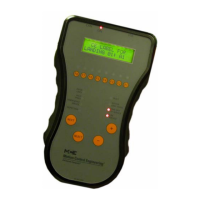The Computer
5-36 Manual # 42-02-1P21
OVL Overload Input - While the car is stopped at a landing with the doors open, the activation
of this input will hold the doors open until the overload condition is cleared by deactivat-
ing the input. Fire Service will bypass OVL.
OVL2
Overload 2 Input - While on Fire Phase II, when the car is stopped at a landing with the
doors open, activation of this input will hold the doors open until the overload condition
is cleared by deactivating the input (only used for the ANSI A17.1-2000 fire code).
PFGE Passing Floor Gong Enable Input - Used mostly on New York City jobs. Normally there is
not an output from the PFG. When this input is momentarily activated there will be a PFG
output as the car passes a floor until the elevator reverses direction (also referred to as
“S” button). Please refer to “PFG ENABLE BUTTON? (Passing Floor Gong Enable Button)”
on page 5-28.
PHE2F Second photo eye input for front doors. Same function as PHE. Required when two PHE
inputs are required for cycle testing. PHE and PHE2F must activate simultaneously to
pass the cycle test.
PHE2R Second photo eye input for rear doors. Same function as PHE. Required when two PHE
inputs are required for cycle testing. PHER and PHE2R must activate simultaneously to
pass the cycle test.
PHER Rear Photo Eye Auxiliary input - May be assigned to SPIN1 - SPIN6 on the HC-CTL board
or to an HC-UIO board input.
PHEX Photo Eye Auxiliary input - This input may be used instead of the PHE (Photo Eye) input
on the HC-CTL board. It may be assigned to SPIN1 - SPIN6 on the HC-CTL board or to an
HC-UIO board input.
PITFLD Pit Flood - Activated by pit flood sensor. When activated, the car recalls to the lowest
landing above flood level, after which it returns to normal service without serving the
inaccessible floors. Renders the floors set in the Extra Features menu “# of flrs below
floor level” inaccessible. Fire, Parking, and Emergency floors, if below flood level, will be
automatically set to the first available landing above floor level.
PSS
Pressure Switch Input - When activated (low), this input will cause the elevator to stop
immediately.
PTI Power Transfer Input - When this input is activated, it causes the car to stop at the next
landing in the direction of travel, open the doors (in accordance with the “LEAVE DOORS
OPEN ON PTI/ESS?” parameter) and shut down. This input is typically used with Emer-
gency Power when transferring from normal power to emergency power (testing) or
emergency power to normal power.
PTIC Complimented PTI Input - Provides reverse logic for the PTI function. PTI operation is ini-
tiated when this input goes low.
R2AB Redundancy monitoring input from the 2AB relay contact. (See description of 2AB input).
R5, R4,
R3, R2
Floor Encoding Inputs - These inputs are required for jobs with absolute floor encoding.
Please refer to “FLOOR ENCODING INPUTS?” on page 5-48.
R2L Redundancy 2L bus. Used to monitor the normally closed contact of an additional 2L
relay.
RBAB Redundancy monitoring input for the BAB relay contact. (See description of BAB input).
RDLSR Rear Door Lock Relay Redundancy input (CSA Redundancy) - This input is used to moni-
tor the state of the DLSR relays (there are 2 relays). This input is activated if either one
of the two relays is “picked” (a normally open contact from one relay is wired in parallel
with a normally open contact from the other relay to feed this input). The logic compares
the state of the RDLSR input with the state of the DLSR input (the DLSR input monitors
the string of actual door lock contacts) to see if one of the two DLSR relays has failed in
the “picked” mode (if DLSR=0 and RDLSR=1, a failure is declared).
Table 5.6 Spare Inputs Menu Options
Spare Inputs Menu Options

